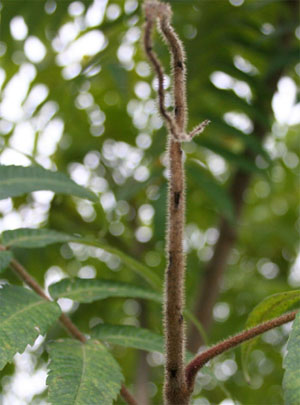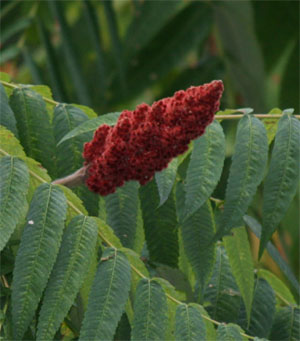Staghorn Sumac
Driving around during September in New York you will eventually come across a group of small trees growing in dense stands. The leaves will be a deep red and large conical red hairy fruits called drupes may be at the end of branches. This is the common Staghorn Sumac which is a deciduous shrub to small tree. It grows quite aggressively. Because staghorn sumac can grow by its roots (rhizomes), and once established it can be a pain to remove.
Description:
Staghorn Sumac grows 10’ – 35’ tall. As can be seen in the picture, the leaves are alternate & compound growing approximately 24” long with 10 – 32 serrate leaflets. Each leaf grows to 12” long. The leaf stalks and the stems are densely covered in rust-colored hairs. Mature trunks are smooth and hairless. Interestingly, only female plants produce flowers and berries. The red berries grow at the end of branches. The plant flowers from May to July and fruit, the drupes, ripen from June to September. As can be seen in the pictures, they grow in upright bunches. Each cluster of drupes may contain 100 to 700 seeds
Habitat:
Staghorn sumac grows in gardens, lawns, the edges of forests, and wasteland. It can grow under a wide array of conditions, but is most often found in open areas which are not already established by other trees.
 Location:
Location:
Staghorn sumac is found throughout the eastern half of the United States and Canada from western Ontario, south to Oklahoma into the Gulf Coast States and eastward to all the Atlantic States and eastern Canada.
Edible:
The fruit of sumacs can be collected, soaked and washed in cold water, strained, sweetened and made into a lemonade-like drink.
Notes of Interest:
Staghorn sumac spreads by seeds, and by its roots, rhizomes, to form “stands”.
The staghorn sumac derives its name from the countless tiny hairs covering its branches and resembling the tines of a deer’s antler when in velvet.
All parts of the staghorn sumac, except the roots, can be used as a natural dye.
Native Americans used the berries from staghorn sumac to make a drink.
The berries and bark are an important source of food for birds (upland games birds as well as song birds) and small mammals.
Staghorn sumac can form with either male or female plants.
